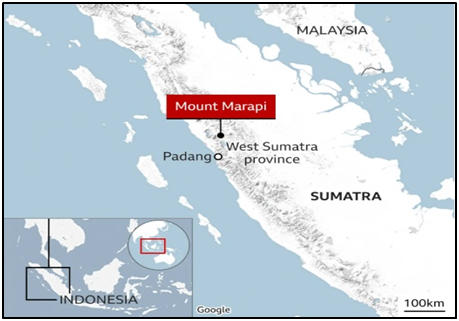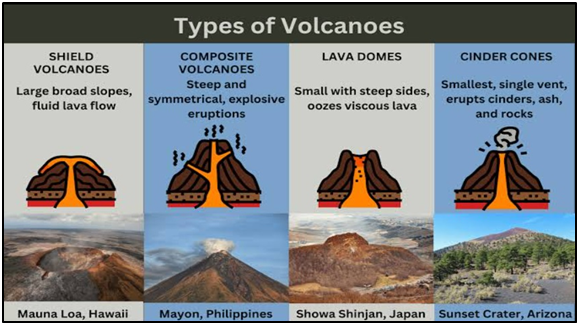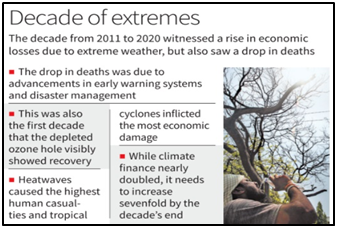Indonesia's Marapi volcano eruption

What’s in today’s article?
- Why in news?
- What is Mount Marapi?
- What is a volcano?

Why in news?
- The death toll from a volcanic eruption in Indonesia has gone up to 22, after rescuers found nine more bodies.
- This eruption of Mt. Marapi was the deadliest since 1979, when an eruption killed 60 people.
- Frequent volcanic eruptions in Marapi have hampered rescue efforts for days.
Mount Marapi
- Mount Merapi is a volcanic mountain peak located near the centre of the island of Java, Indonesia.
- It is located on Sumatra, the westernmost and third largest of Indonesia's 18,000 islands. It stands 2,891m high.
- Mount Marapi, which means "Mountain of Fire", is among the most active of Indonesia's 127 volcanoes and is also popular among hikers.
- The Indonesian archipelago sits on the so-called Pacific Ring of Fire, where the meeting of continental plates causes high volcanic and seismic activity.
What is a volcano?
- About
- Volcanoes are openings, or vents where lava, tephra (small rocks), and steam erupt onto the Earth’s surface.
- Volcanoes can be on land and in the ocean.
- They are, in part, a result of their own eruptions but also the general formation of our planet, as tectonic plates move.
- Mountain ranges like the Andes in South America and the Rockies in North America, as well as volcanoes, formed through the movement and collision of tectonic plates.
- Types
- There are four main types of volcanoes: cinder cones, composite or stratovolcanoes, shield volcanoes and lava domes.
- Their type is determined by how the lava from an eruption flow and how that flow affects the volcano, and, as a result, how it affects its surrounding environment.
- Volcanoes can also be classified as:
- Active: Have a recent history of eruptions
- Dormant: Have not erupted for a long time but may erupt in the future
- Extinct: Are not expected to erupt in the future
- Eruption
- Essentially, it is a case of magma, or molten rock, below the surface of the Earth, bubbling up, rising and overflowing, like boiling milk out of a pot on a stove.
- The magma finds its way to vents in the volcano and gets spewed across the land and into the atmosphere.
- When magma erupts from a volcano, it is called lava.
Q1) What is Pacific Ring of Fire?
The Pacific Ring of Fire, also known as the Circum-Pacific Belt, is a tectonic belt that surrounds the Pacific Ocean. It's a horseshoe-shaped region that's about 40,000 kilometers long and up to 500 kilometers wide.
Q2) What is dormant volcano?
A dormant volcano is a volcano that has not erupted recently but is expected to erupt again.
Source: Indonesia's Marapi volcano eruption leaves 22 dead; one still missing | British Geological Survey | BBC

Indonesia's Marapi volcano eruption
The Global Climate 2011-2020: A Decade of Acceleration

What’s in today’s article?
- Why in news?
- World Meteorological Organization (WMO)
- What is the WMO?
- News Summary: The Global Climate 2011-2020: A Decade of Acceleration
- About the report
- Key highlights of the report

Why in news?
- “The Global Climate 2011-2020: A Decade of Acceleration” is a report published by the World Meteorological Organization (WMO).
World Meteorological Organization (WMO)
- The World Meteorological Organization (WMO) is an inter-governmental organisation with a membership of 193 Member States and Territories.
- It originated from the International Meteorological Organisation (IMO - a NGO), the roots of which were planted at the 1873 Vienna International Meteorological Congress.
- Established by the ratification of the WMO Convention on 23 March 1950, WMO became the specialised agency of the UN, responsible for promoting international cooperation on -
- Meteorology (weather and climate),
- Operational hydrology and
- Related geophysical sciences.
- The WMO's Strategic Plan includes -
- Disaster risk reduction,
- The Global Framework for Climate Services (GFCS),
- The WMO Integrated Global Observing System (WIGOS),
- Aviation meteorological services,
- Polar and high mountain regions,
- Capacity development and Governance.
- The Secretariat, headquartered in Geneva, is headed by the Secretary-General and its supreme body is the World Meteorological Congress.
- WMO publishes - Greenhouse Gas Bulletin, Status of Global Climate, etc., reports
News Summary: The Global Climate 2011-2020: A Decade of Acceleration
About the report
- Published by WMO, The Global Climate 2011-2020: A Decade of Acceleration report was released at the UN Climate Change Conference, COP28.
- The report provides a longer-term perspective and transcends year-to-year variability in our climate.
- It compliments WMO’s annual State of the Global Climate report.
- It documents how extreme events across the decade had devastating impacts, particularly on food security, displacement and migration, hindering national development and progress toward the Sustainable Development Goals (SDGs).
- It is based is based on physical data analyses and impact assessments from dozens of experts at National Meteorological and Hydrological Services, Regional Climate Centres, National Statistics Offices and United Nations partners.
Key highlights of the report
- Warmest decade in the history
- The decade from 2011-2020 was the warmest ever in history.
- Also, there has been a rise in economic losses from extreme weather and climate losses.
- Number of casualties from extreme weather and climate events has gone down
- The reports highlight that number of casualties from extreme weather and climate events has gone down substantially over time.
- The 2011-2020 decade was the first since 1950 when there was not a single short-term event with 10,000 deaths or more.
- A major contributor to this decrease has been improved early warning systems, driven by improvements in forecasting, coupled with improved disaster management.
- Depleted ozone hole visibly showed recovery
- The report also says that this was the first decade that the depleted ozone hole visibly showed recovery.
- The success of the Montreal Protocol is the inspiration for the United Nations-led climate charter to convene annual Conference of Parties-meetings to address the challenge from greenhouse gases and climate change.
- The Montreal Protocol is a treaty that brought countries together to agree on phasing out ozone-depleting gases, particularly refrigerants.
- Thinning of glaciers
- Glaciers that were measured around the world thinned by approximately 1 metre per year on average between 2011 and 2020.
- Greenland and Antarctica lost 38% more ice between 2011 and 2020 than during the 2001-2010 period.
- The report cited no specific reference to Himalayan glaciers but had one mention of the 2021 Uttarakhand rock-avalanche that was triggered from a breach in the Nanda Devi glacier in the Himalayas.
- Extreme heat events and their impact
- The report underlined that human caused climate change significantly increased the risks from extreme heat events.
- Heatwaves were responsible for the highest number of human casualties, while tropical cyclones caused the most economic damage.
- Gap in climate finance
- As per the report, public and private climate finance almost doubled between 2011 and 2020.
- However, it needed to increase at least seven times by the end of this decade to achieve climate objectives.
Q1) What is the specialised agency of the UN?
UN specialized agencies are international organizations working with the UN, in accordance with relationship agreements between each organization and the UN. Specialized Agencies each have a process for admitting members and appointing their administrative head.
Q2) What is International Meteorological Organization (IMO)?
The International Meteorological Organization (IMO) was a non-governmental organization that was founded in 1873. The IMO was the first organization to exchange weather information between countries.
Source: Warmest decade in history also saw drop in deaths from ‘extreme climate events’: World Meteorological Organisation | World Meteorological Organisation | WMO

The Global Climate 2011-2020: A Decade of Acceleration
India-Kenya Bilateral Relationship

What’s in Today’s Article?
- Why in the News?
- India-Kenya Bilateral Relationship
- News Summary

Why in the News?
- India has extended a $250 million Line of Credit for modernisation of agriculture in Kenya.
India-Kenya Bilateral Relationship
- India established the office of Commissioner for British East Africa resident in Nairobi in 1948.
- Following Kenyan independence in December 1963, a High Commission was established in Nairobi, capital of Kenya.
- India has had an Assistant High Commission in Mombasa, coastal city in southeastern Kenya.
- Vice President Dr. S Radhakrishnan visited Kenya in July 1956.
- The State visit of PM Narendra Modi to Kenya in 2016 gave a new impetus to bilateral partnership.
- Bilateral Trade:
- An India-Kenya Trade Agreement was signed in 1981, under which both countries accorded Most Favored Nation status to each other.
- As a follow-up to the Agreement, the India-Kenya Joint Trade Committee (JTC) was set up at Ministerial level in 1983.
- A bilateral Double Taxation Avoidance Agreement (DTAA) was signed in 1989.
- Revised DTAA was signed in July 2016 and came into force in 2017.
- Exports:
- In 2021, India exported $2.55B to Kenya.
- The main products that India exported to Kenya are Refined Petroleum ($504M), Packaged Medicaments ($253M), and Semi-Finished Iron ($149M).
- During the last 26 years the exports of India to Kenya have increased at an annualized rate of 9.46%, from $243M in 1995 to $2.55B in 2021.
- Imports:
- In 2021, Kenya exported $107M to India.
- The main products that Kenya exported to India were Dried Legumes ($42.8M), Carbonates ($20.5M), and Tea ($11.7M).
- Development Cooperation:
- India offers development assistance to Kenya in the form of loans and credit.
- This includes a loan of Rs. 50 million to Government of Kenya in 1982 and Lines of Credit by EXIM Bank to Industrial Development Bank Capital Ltd.
- Social Ties:
- About 80,000 to 100,000 people in Kenya are of Indian origin.
- This makes Kenya the African country with the largest Indian community after South Africa.
- The Kenyan government in 2017, recognized the Indian descent as the 44th tribe in the country.
- India is the third largest source (other than neighbours) of inbound tourists to Kenya.
- There are about 3,500 Kenyan students currently studying in 50 Institutions throughout India.
News Summary
- Kenyan President William Samoei Ruto is on a three-day state visit to India.
- India and Kenya looked to boost defence, maritime and connectivity ties as Prime Minister Narendra Modi held talks with visiting President William Ruto.
- PM Modi announced a new $250 million line of credit to help the east African country improve its agriculture sector.
- The two countries also signed five agreements and issued a vision document for maritime cooperation in the Indian Ocean.
- Looking to intensify defence cooperation, the leaders agreed to continue working towards expanding training exchanges, including deputation of Indian experts, in Kenyan defence institutions.
- PM Modi said both sides will carry out joint military exercises and will collaborate on counter-terror projects.
Q1) What is the meaning of Diplomacy?
Diplomacy is the art and science of maintaining peaceful relationships between nations, groups, or individuals.
Q2) What is the Horn of Africa?
The Horn of Africa, also known as the Somali Peninsula, is a large peninsula and geopolitical region in East Africa. Located on the easternmost part of the African mainland, it is the fourth largest peninsula in the world.
Source: India provides $250 million Line of Credit to Kenya for agricultural modernisation | TOI




